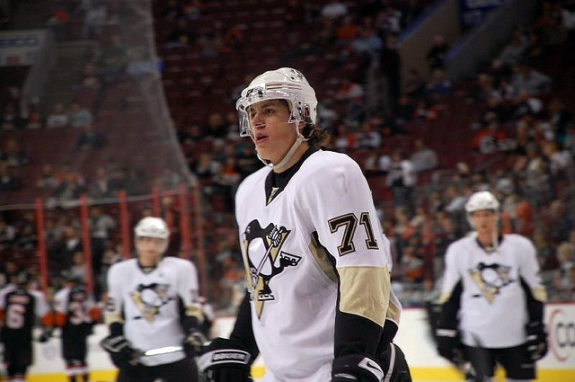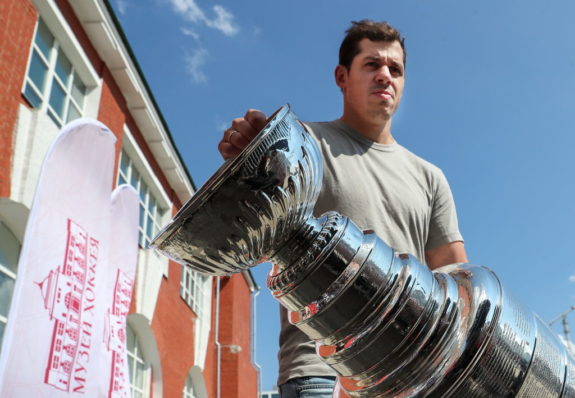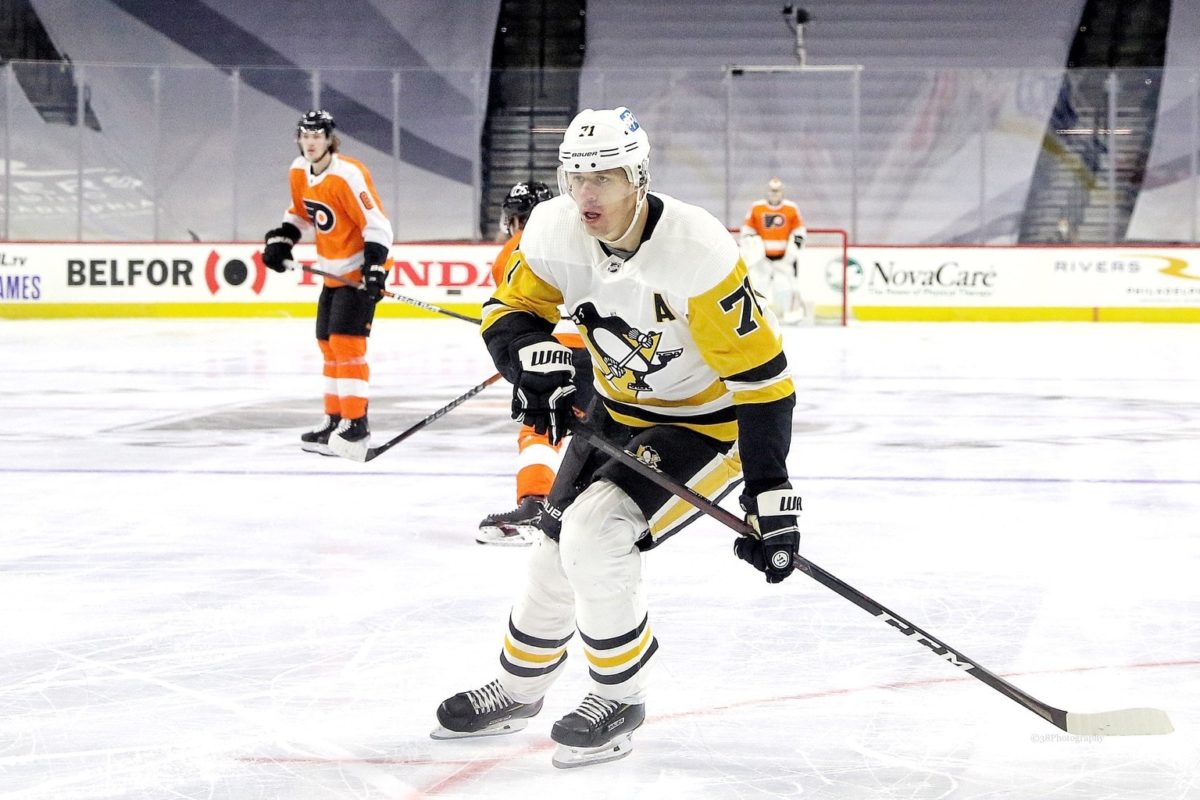Evgeni Malkin is an enigma.
The man has spent his NHL career as the second-best center on the Pittsburgh Penguins but is also one of the four most important players in franchise history along with Mario Lemieux, Sidney Crosby, and Jaromir Jagr. He has led the team to countless wins but has been blamed for quite a few losses. He is loved in Pittsburgh while faced with unending trade speculation.
Malkin is Crosby’s proverbial sidekick, making it possible for differing opinions on his value to exist. And trade rumors swirled again after the Penguins were eliminated by the New York Islanders in the first round of the Stanley Cup Playoffs. A trade is not expected to happen, as Pittsburgh will likely look relatively similar entering next season.
But the idea of trading Malkin was again brought up by those outside the team, even if for just a moment. So, let’s look at why he seems to be considered dispensable.
A Career Spent On a Hypothetical Trading Block
It’s difficult to remember when a Malkin trade wasn’t discussed. It could come from fans. Maybe from the media. Either way, it seemed to always be there.
It goes back to at least 2010. Malkin won the Conn Smythe Trophy as MVP of the 2009 Stanley Cup Playoffs. A year later, the defending-champion Penguins were ousted in the second round by the Montreal Canadiens.

Malkin wasn’t particularly effective. He had just 11 points (five goals, six assists) in 13 playoff games in 2010. But it was his fourth NHL season after making the Stanley Cup Final the previous two. Retaining a generational talent that was a primary catalyst to the 2009 championship should have been considered beneficial.
But some fans (probably a vocal minority, to be fair) wanted Malkin gone. That discourse has occurred almost every time the Penguins have failed to win a championship. Actually, rumors still existed after Pittsburgh hoisted the Cup in 2016.
It has become a persistent reality.
You may also like:
- Penguins’ Kyle Dubas Already on the Hot Seat This Season
- 4 Things Patrick Roy Can Learn From Jon Cooper & Mike Sullivan
- Pittsburgh Penguins’ 10 Best Defensemen in Team History
- Hockey History – the NHL “Second Six”
- Penguins’ Projected 2024-25 Opening Night Lineup
Penguins lose to the Canadiens in 2010 — Malkin could be traded. Penguins get swept by the Bruins in the 2013 Eastern Conference Final — Malkin could be traded. Before the Penguins let a 3-1 series lead slip to the New York Rangers in 2014 — Malkin could be traded.
Why Malkin?
First, Malkin is not Crosby. That’s simple enough.
Malkin, as important as he is, has always been the second-best player on his team. There was a time where he could have been considered the third-best player in the world, behind Washington Capitals forward Alex Ovechkin, but Crosby was (and is) better. Fans weren’t going to want to part with the face of the NHL. It’s easier to let go of the other guy.

Malkin’s play also presents an issue. In any given game, he could be dominant. When provoked, he often comes up with three points or so. But it can go the other way, as well. He can implode, taking questionable penalties and putting Pittsburgh in unenviable positions. Fans become frustrated. Defenseman Kris Letang has the same issue. That leads some to question whether Malkin and Letang are more trouble than they’re worth. The answer is no. They’re two of the most valuable players in franchise history. Still, the narrative exists.
Then there’s the city of Pittsburgh, a town that wants to move on from history as much as it wants to hold on to it.
Pittsburgh spent Marc-Andre Fleury’s Penguins career dreaming of a replacement, just to clamor for the goalie to return a few years after heading to Vegas. After years of booing Jagr, it was incensed when he joined the cross-state rival Philadelphia Flyers instead of coming back to Pittsburgh in 2011-12.
It’s not even limited to hockey. In 2019, some in the city wanted the Pittsburgh Steelers to replace quarterback Ben Roethlisberger, a two-time Super Bowl champion, with Devlin Hodges, a third-string QB who (and this is not a joke) is also a duck caller.
But like Roethlisberger, Malkin is likely to get at least one more season in Pittsburgh. Roethlisberger might, and probably will retire after this upcoming NFL season. Malkin isn’t expected to be done after 2021-22 but will require a new contract to stay with the Penguins.
If Malkin does move, it would temporarily end his lengthy, strange relationship with a city that has adored him while also trying to get rid of him.
Malkin’s Legacy in Pittsburgh
Lemieux. Crosby. Jagr.
Malkin is with those three as the greatest players in Penguins history, and would likely be considered third ahead of Jagr if he stays in Pittsburgh the rest of his career. He ranks second in games played for the Penguins (940), behind Crosby (1,039). Malkin is third in points (1,104), fourth in goals (424), and third in assists (680).
As mentioned, it was Malkin who won the Conn Smythe when he and Crosby first hoisted the Stanley Cup in 2009. He had 36 points (14 goals, 22 assists) in 24 games that postseason.

With Crosby playing just 22 games in 2011-12, Malkin won the Hart Trophy as NHL MVP with 109 points (50 goals, 59 assists) in 75 games. He also won the Art Ross Trophy as the league’s scoring champion that season, doing so a second time after winning it with 113 points (35 goals, 78 assists) in 2008-09.
Malkin had a combined 46 points (16 goals, 30 assists) in 48 games when the Penguins won the Stanley Cup in 2016 and 2017. The Russian averaged 1.23 points per game through his first six NHL seasons. That’s not far off from Crosby’s 1.39 points per game through his first six. Malkin scored .49 goals per game his first six seasons, just short of Crosby’s .51 in his first six.
But Crosby is considered at least a top-10 player all-time, while in 2017, Malkin was not included on the NHL’s list of top 100 players in league history.
In a 4-1 win against the Boston Bruins on March 15 this season, Malkin had a goal and an assist to reach 1,100 NHL points. He joined Lemieux and Crosby as the only Penguins to reach that mark. The following day, he sustained a knee injury while Pittsburgh lost 2-1 to Boston. He ultimately missed the first two games of the series against the Islanders. The injury required offseason surgery, which will hold him out through at least training camp. That led to the most recent bouts of trade speculation.
Latest Trade Rumors
Malkin turns 36 today and is entering the first year of what could be his final contract. His production has become less consistent. He was disappointed in the 2018-19 season when he had 72 points (21 goals, 51 assists) in 68 games but was a career-low minus-25 and led the Penguins with 89 penalty minutes.
The next season was vintage Malkin – 74 points (25 goals, 49 assists) in 55 games during 2019-20. The rating improved to a plus-7. The penalty minutes decreased to 58.

But Malkin was hard to gauge in 2020-21 season. He took a while to get going with seven points (three goals, four assists) in his first 14 games. As soon as he started to look like himself, the knee injury derailed him in mid-March.
Age. Wear and tear. Inconsistency.
Those are all adequate reasons to part from Malkin. Maybe get something back while his value is still relatively high. Possibly shed at least some of his $9.5 million cap hit and use it to make the Penguins viable contenders for what remains of Crosby’s prime.
It won’t happen, though. General manager Ron Hextall said he doesn’t intend to break up Pittsburgh’s core of Crosby, Malkin, and Letang. And keeping Malkin, even if he’s not the player he once was, is probably the correct move. In fact, Hextall said discussions of possible contract extensions for the forward and Letang were ongoing as of his end-of-season media availability on June 2.
Still, moving Malkin was reasonable at the end of this season. But just because it’s reasonable now doesn’t mean it always was.
